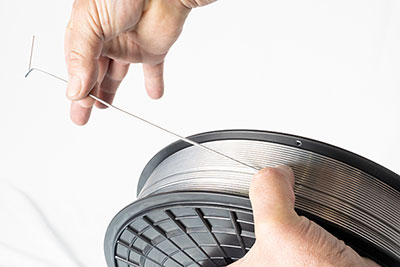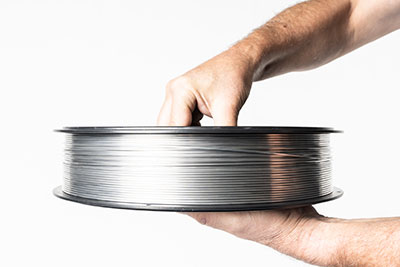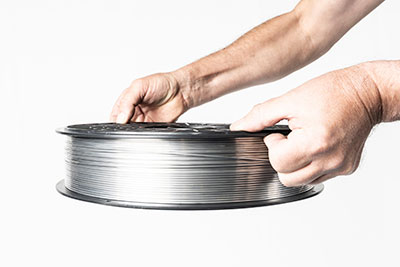Technical advice
Aluminium. Welding
Aluminium is a light metal with a density of 2,7kg/dm3, silver-coloured and relatively soft, depending on the alloy in comparison to other metals for industrial use.
As for technological know-how, the most important part for the application of the welding process are its low density, high thermal conductivity, the presence of an aluminium rust layer (alumina Al2/O3), high sensitivity to the onset of porosity inside the weld metal and low mechanical properties.
Low density
The low density of aluminium has an advantage when welding in PF, PD and even PE positions, gravity does not cause detachment and spilling of liquid metal from the molten bath. This means that we can weld aluminium in the positions mentioned above without any major problems.
However, and in every position, aluminium presents a disadvantage: when the molten bath is located between the electric arc and the weld joint, the fusion of the base metal can cause problems. This is known as “lack of fusion” or “cold lapping”. This is because the base metal is not being directly attacked by the electric arc, so the fusion must be produced by the contact with the liquid metal coming from the filler material. Due to its low density, the molten metal is not heavy enough, so it does not exert any contact pressure for the metal base to fuse.
In order to avoid this problem, the electric arc must be positioned slightly before the molten bath, so that it is the arc itself that fuses the joint and the filler metal can create the seam.
This defect happens more often when the molten bath is small, which is the same as saying (in terms of welding) that the lower the thermal input, the higher the possibility of this defect appearing.
This defect mainly happens the smaller the molten bead is. Regarding to the welding process, the lower the thermal input, the greater the possibility of the defect occurring.

High thermal conductivity
This technological capability means that, once the electric arc has been established over the joint, a certain amount of time passes before the joint melts. Even though aluminium has a lower fusion point compared to other welding metals, the heat introduced by the electric arc is easily evacuated through the sheet or the component to be welded. Normally, the thicker the material to be welded, the more easily this phenomenon occurs.
Similarly, due to the high thermal conductivity of aluminium, the initial welding processes are prone to the onset of lack of fusion or penetration defects (in both GMAW-MIG and GTAW-TIG).
This is not a problem in GTAW-TIG welding, given that the worker decides when to start the metal filling once the electric arc has been established.
However, in GMAW-MIG, the electric arc starts at the same moment as the filler metal is introduced in the process, so fusion happens from the beginning. As a consequence, liquid metal is deposited on cold metal, which is the cause of the lack of fusion or penetration at the beginning of the weld bead.
This happens more often when the components are thicker, due to their high capacity to evacuate the heat.
There are several solutions to this problem, some of which are:
- a) Pre-heating the components to be welded
- b) Beginning to weld outside the joint and then move towards it (this normally involves sanding off the area welded outside the joint afterwards)
- c) Putting aluminium material next to the joint to begin welding on it, and then move on to the actual joint
- d) Other solutions developed by manufacturers.
Furthermore, the junction section between weld beads deserves particular attention. In this case, the most advisable measure is to mill the end of the bead to join (manual milling) at an angle, causing the so-called “ramp” to appear. The beginning of the new bead will take place on top of the bead to be joined, moving on through the ramp. This way, the lack of fusion will be located on top of the previous bead. By sanding it off later, we get rid of the excess material and the lack of fusion.
Presence of an aluminium rust layer or alumina
Alumina’s melting point is higher than that of aluminium (2062ºC to 660ºC). Therefore, this layer must be removed mechanically or using a brush with stainless steels spike before welding.
In GTAW-TIG, alternating current is preferred.
High sensitivity to the onset of porosity
Aluminium welding is very sensitive to the onset of pores in the weld metal. The most frequent causes are related to the presence of H2.
We could establish that the reduced level of PPM of this gas is the main cause for this problem.
Therefore, special attention must be paid to air currents in the welding area, damp, moisture on the sheets or on the wire, the wire itself, the gas used in the pre-heating process (the use of propane is not advisable) and any possible dirt that might release H2 when combusting (cutting fluid or other lubricants).
Low mechanical properties
Aluminium can be considered a soft metal.
This means that it may shed some shavings if the wire feeder in a GMAW-MIG set is not in good condition, the rollers are not apt for aluminium or simply if the feeder is too tight. In this case, part of these shavings will be dragged by the wire itself towards the inside of the welding torch and lead to blockage.
The tube that holds the aluminium located inside the welding torch must be suitable and have an inner diameter that allows the free circulation of the filler metal.
The contact tip must be apt for use with aluminium
Spools Manipulation
Security advices
Handling risks:
- The beginning and end of the wire might produce injuries.
- Fall of spools might cause hits.
- Unsuitable warehousing might cause collapses.
- Piling spools up is unstable and can produce hits.
Measures to be taken:
- It is recommended the use of gloves in spools handling
- It is recommended the use of the security shoes.
- It is recommended not to pile spools up out of its original packaging.
These instructions must be available at each area /place where the spools are handled.
Independently of the advices included in these instructions, local security rules will be applicable.
The manufacturer is not responsible for damages as consequence of an incorrect or unsuitable use of the delivered material.
Storage Recommendations
It is recommended to use the material no later than 18 months from its reception, as long as it is kept in its original packaging and stored somewhere protected from humidity and dirt. Once the package is opened, and in case of not using all the material, keep into its original case closed and preferably in a heated cabinet, at least at 20°C.
Avoid the wire contamination with foreign substances.
Recommendations of using
Letting go the wire (freely) in the feeding process of the machine could produce spring effect, and the spires could come out from their accommodate. We recommend to hold with the hands the superficial spires to avoid this effect before hooking the wire to the metallizing machine.

Avoid wire crosses in the feeding process of the machine because they will cause serious problems in the correct working.
Avoid the fall of spools in the process of handling them, because it will cause the breakage of the spools. Take special care with handling of the spools type IRU 320.
YES.

NO.

Environmental information
Plastic reels can be reused and recycled; packagings materials can be recycled.
The end user is responsible of managing the residues in a suitable way, according to the European Directive 94/62/CE or local rules.

